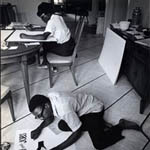By Christopher Harter, Director of Library and Reference Services, Amistad Research Center
 “Working for Freedom: Documenting Civil Rights Organizations” is a collaborative project between Emory University’s Manuscript, Archives and Rare Book Library, The Auburn Avenue Research Library on African American Culture and History, The Amistad Research Center at Tulane University, and The Robert W. Woodruff Library of Atlanta University Center to uncover and make available previously hidden collections documenting the Civil Rights Movement in Atlanta and New Orleans. The project is administered by the Council on Library and Information Resources with funds from the Andrew W. Mellon Foundation. Each organization regularly contributes blog posts about their progress.
“Working for Freedom: Documenting Civil Rights Organizations” is a collaborative project between Emory University’s Manuscript, Archives and Rare Book Library, The Auburn Avenue Research Library on African American Culture and History, The Amistad Research Center at Tulane University, and The Robert W. Woodruff Library of Atlanta University Center to uncover and make available previously hidden collections documenting the Civil Rights Movement in Atlanta and New Orleans. The project is administered by the Council on Library and Information Resources with funds from the Andrew W. Mellon Foundation. Each organization regularly contributes blog posts about their progress.
For more information about the collection described in this post, please contact the Amistad Research Center, reference [at] amistadresearchcenter [dot] org
Around the same time that the Amistad Research Center was awarded a grant from the Council on Library and Information Resources (CLIR) in 2008 to assist the Center in identifying and cataloging “hidden” archival collections, the Center was also seeking to increase the use of undergraduate and graduate students in helping to process and preserve its collections. These two initiatives have worked hand in hand to greatly assist the Center in increasing access to its collections and give young scholars experience working in an archival setting.
Since the spring 2009 semester, Amistad has hosted 11 individual interns from area colleges and universities, and even one local high school, as part of its Young Archivists Mentoring Program. The students, many of whom are from underrepresented populations, have greatly assisted the Center in exposing a number of significant, but unprocessed, collections. In addition, the Center has hosted two service-learning classes from Tulane University’s History Department, in which each student devoted 20 hours of community service to the Center. Since the mentoring program began, Amistad has received a total of over 800 hours of assistance from students!
Properly training and supervising student assistants can take a lot of staff time, but as part of its CLIR project, Amistad staff formalized a policy and procedure manual that has been a useful training tool for interns. The manual encompasses all areas of the Center’s operations, but the sections on archival arrangement and preservation have been especially beneficial for students. Group training sessions have also allowed the Center’s staff to maximize training in a shorter amount of time. Training includes an introduction to the Center and its history, which helps the students understand the value of their work at the Center – not only for the Center but the researchers who regularly visit. Training also includes an introduction to archival arrangement and description, finding aids, and basic preservation techniques.
One of the overall goals of Amistad’s mentoring program is to form a mutually beneficial relationship between the Center and the student. To do so, Center staff work to select collections that match not only Amistad’s priorities, but the students’ interests. For example, an art history major processed the papers of Harlem Renaissance sculptor Richmond Barthe, while a theater and history major processed the papers of soprano Anne Wiggins Brown. Prior to working on a collection, students and staff review the acquisitions documentation for the collection and conduct a collection survey. Students then begin to draft a biographical or historical note while conducting the survey in order to contextualize the collection.
While processing the collection, students refer to the policy and procedure manual as needed, but also communicate with staff as questions arise. Effective communications have been a key component of the student mentoring program. Amistad has made use of simple composition books that students use as work journals to chart their progress, plan their steps, and leave notes for staff in between work sessions.
By tying the mentoring of students with Amistad’s increased efforts to expose its “hidden collections,” the Center has been able to process and make available a number of significant collections that would not have been possible due to staff size. The Center is also contributing to the growth of the archival profession by providing an introduction to archival work and methodologies, especially to minority students. The Center is continually refining its mentoring program, but success has been measured by the number of students who have continued to volunteer or request internships at the Center following their initial time working at Amistad. At least one student has gone on to enroll in a library science program with an archival emphasis after completing her internship at the Center. Not only is Amistad’s staff working to expose hidden collections, but we may be exposing some future hidden archivists, as well!
Above: Graduate student Nika B. Carter (Southern University-New Orleans) processing the Marr-McGee Family Papers
Above: Undergraduate student Newton Hippolyte (Tulane University) processing the Harold Battiste Papers
*Amistad staff presented a version of this information at the 2010 RBMS Preconference in Philadelphia in June 2010 and the Center’s partnership with service-learning classes will be included as a case study in the forthcoming ACRL publication, tentatively titled “Past is Portal: Teaching Undergraduates Using Special Collections and Archives.”
